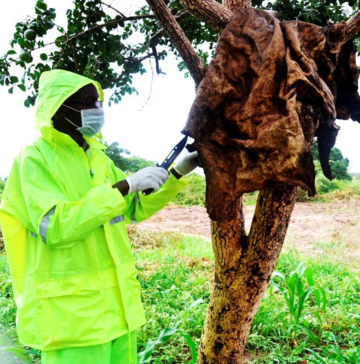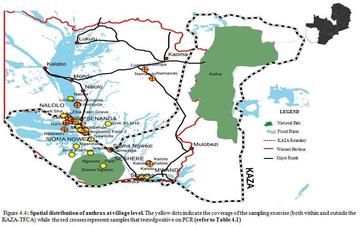Harvey Kakoma Kamboyi
Last update: 5 March 2019
SUMMARY
Anthrax is an acute and invariably fatal zoonotic disease affecting multi-species and caused by a bacteria, Bacillus anthracis. In Zambia, anthrax has emerged as a serious ecosystem disease resulting in mortalities across humans, livestock and wildlife. The disease has had devastating effects on tourism resulting in socio-economic destabilisation of three pristine wildlife sanctuaries, namely the upper Zambezi basin, the Lower Zambezi and the Luangwa valley. Preliminary trend analysis revealed sporadic annual outbreaks in the upper Zambezi basin. Consequently, the thrust of this study was to establish the spatial distribution of anthrax and determine ecological drivers of its recurrence, maintenance and epidemiological linkage to human activities in the study area.
Particular emphasis was given to establish an epidemiological linkage between socio-cultural and economic activities of the inhabitants and the incidence of anthrax at ecosystem level. Environmental and biological samples were collected within the livestock production and conservation areas (n=80). Questionnaires (n=113) and focused group interviews (n=4) were conducted at independently distinct villages in terms of space and time. Interviewees admitted consuming animals that died from anthrax and consequently suffered from the cutaneous form of anthrax. They were not aware of the fatal pulmonary and gastrointestinal forms of the disease. “Hunger for meat” being the main driver of consumption of anthrax carcasses contributed to environmental contamination with anthrax spores through dressing of anthrax carcasses where they lay resulting in environmental contamination, which is a major source of primary infection for livestock and wildlife.
These socio-cultural activities together with lack of anthrax knowledge strongly intimate their contribution to anthrax recurrence and maintenance in the upper Zambezi basin. From the samples, fifteen (15) pure isolates of anthrax were obtained which were spatially distributed across four districts. Twelve, biologically plausible variables were found to be highly significant on multivariable logistic regression analysis model for questionnaires which included herd size (odds = 10.46; p = 0.005; CI 8.8-16), anthrax consumption (odds = 6.9; p = 0.001 ; CI = 3.4-9.8), veterinary services (odds = 10.87; p = 0.004; CI = 4.8-15.9) and management system (odds = 2.57; p = 0.001 ; CI = 1.3-7.5). In summary, the majority (78.7%) of anthrax outbreaks were observed in areas with low veterinary services (χ2 = 8.6162, p = 0.013) within the newly created districts of Nalolo, Mwandi and Luampa. This study has revealed that the quality veterinary services are critical in preventing anthrax outbreaks. We therefore highly recommend strengthening of veterinary and livestock extension services delivery and establishing a government anthrax surveillance programme for early detection, vaccination and decontamination of anthrax graves within the upper Zambezi basin. In that effect, there is need to embark on public health awareness campaigns aimed at promoting active participation by the general public in the control of anthrax in the identified hotspots and surrounding areas.
Last update: 5 March 2019


